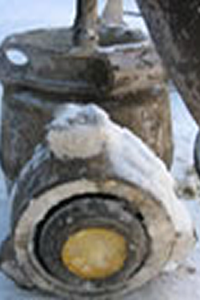Two workers struck by piping when ice plug released
Two workers struck by piping when ice plug released
Date of incident: January 2011
Notice of incident number: 2011124490003
Employer: Gas well servicing company
Incident summary
Workers were conducting hydraulic fracture stimulation processes on a gas well. During the process, the crew suspected that a hydrate (ice plug) had formed in the 2-inch diameter iron piping used to deliver pressurized nitrogen gas (N2) to the wellhead. The hydrate blocked the flow of N2 from pumps through the piping, so the fracturing process and pumping of N2 was stopped. Crew members bled off the N2 in part of the line to eliminate pressure.
In the attempt to address the blockage, workers attempted to take the piping apart by breaking the hammer unions on both ends of a 4-foot section of the iron piping, but they could not break the unions. They proceeded to move upstream to a valve and were able to break the union apart there, where they discovered an ice plug. The workers did not know that there was a second ice plug in a portion of the iron piping that was still connected to the buffalo head (a component mounted on the wellhead that allows multiple entry points into the well bore from different lines). Pressure was trapped in the line between the two ice plugs.
A steam line was brought in to warm the piping and thaw the ice plug that the crew had found. One of the workers continued efforts to break apart an additional part of the line by hammering. The ice plug released, and the sudden release of pressure caused a short section of the iron piping to lift the line off the ground and rotate uncontrollably. Two workers were struck by the rotating iron piping and sustained serious injuries.
Investigation conclusions
Causes
- Workers struck by uncontrolled hazardous movement of N2 line: Pressure trapped between two ice plugs in the iron N2 line unexpectedly released. The line was disconnected on one end, and it rotated violently during the pressure release. Two workers were struck by the N2 line and sustained serious injuries.
- Insufficient hazardous energy controls: There was no isolation or control of the hazardous energy that was trapped in the N2 line due to the absence of controls in that portion of the line. Additionally, the swivel joints and a long pipe section were not secured from hazardous movement, which enabled these components to strike and injure workers.
- Lack of hazard recognition: The crew members, including the two supervisors, believed that the situation they faced with the obstructed N2 line was likely due to a single ice plug. They therefore inadequately considered the potential for multiple ice plugs, and serious hazards were not recognized.
- Inadequate measures to prevent development of hydrates: Preventive measures to prevent hydrate formation were not followed, such as using steam lines to keep the temperature of the N2 line elevated. The line was rigged in such a fashion as to form a stagnant pressurized portion, and the lack of circulation contributed to the risk of hydrate formation.
- Failure to establish hydrate management procedures for N2 lines: The crew did not follow best practices with respect to dealing with hydrates. The employer did have some procedures for hydrate management in other types of lines used in its operations, but did not have hydrate management procedures specific to N2 treatment lines.
- Unsafe disconnection of a union on a line under pressure: There was no means to determine if pressure was still present in the portion of the line that remained connected to the buffalo head. Pressure was present, and hammering on the connectors on the line likely caused the ice plug near the manual isolation valve to release.
- Remote hydraulic isolation valve not in proper operating condition: The employer had recently non-destructively tested the remote isolation valve that was installed on the buffalo head and had used it without difficulty during the week before the incident. However, on the day of the incident, the valve was defective due to torn segment seals inside it. The valve leaked and would not withstand pressure. The leaks allowed water and fluid to form one hydrate in the remote valve and enter the N2 line and form a second hydrate by the manual isolation valve installed on the line at ground level. The remote isolation valve should have been inspected before installing it to prevent a defective valve from being put into service on the day of the incident.
- Incorrect interpretation of cause of N2 pressure loss: The crew did not sufficiently pressure-test the N2 line before fracturing operations were conducted. When N2 pressure dropped repeatedly, the workers who monitored the pressures did not consider that internal failures of components were contributing to the loss of pressure.

